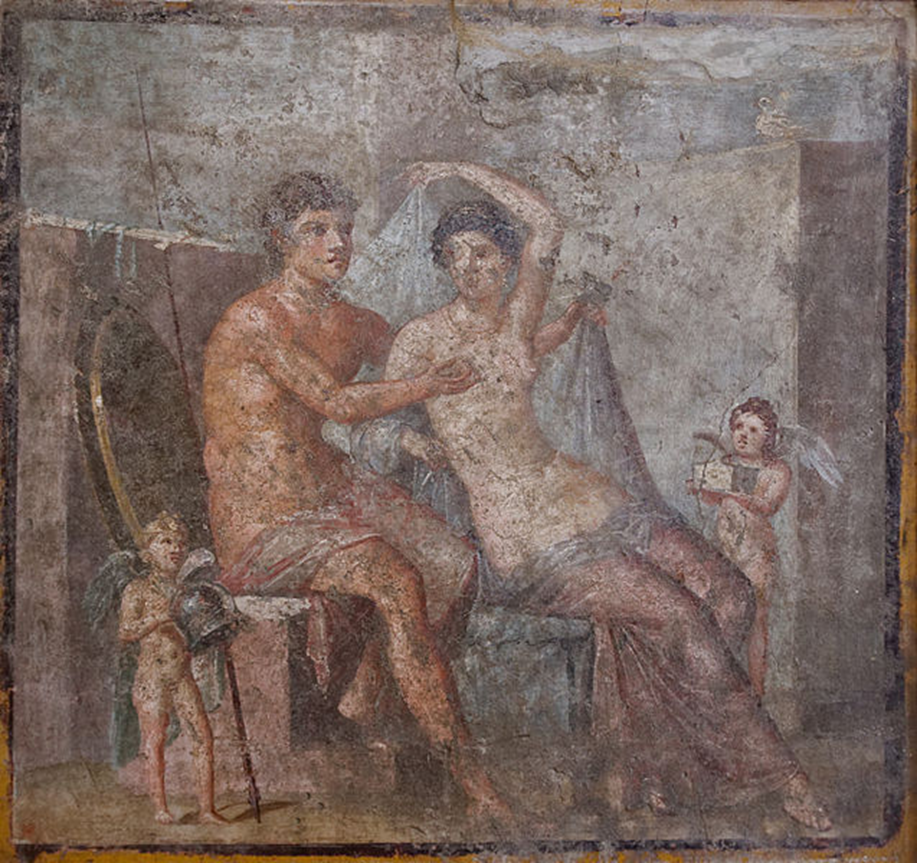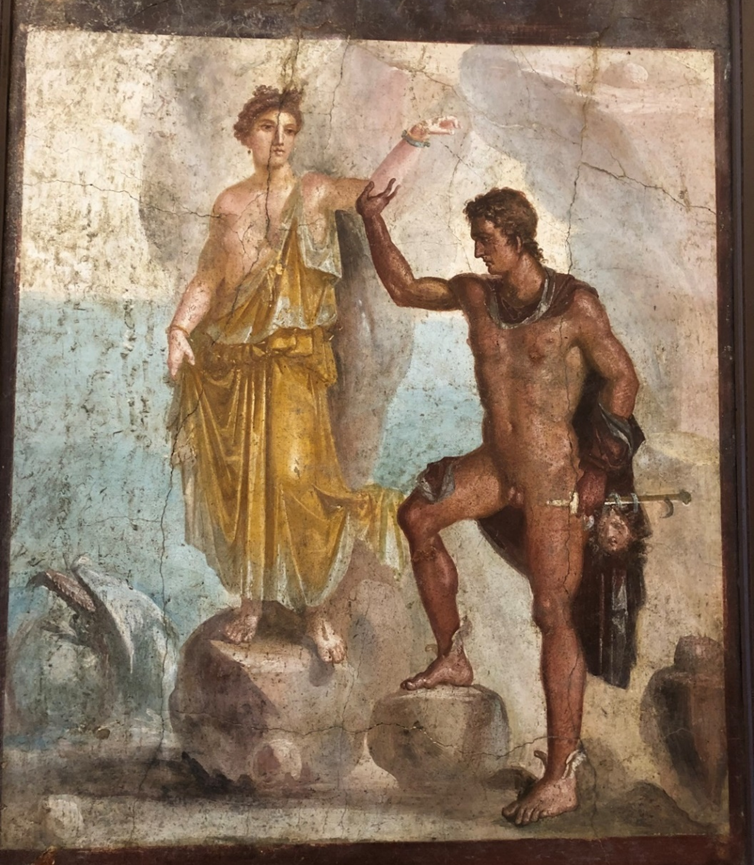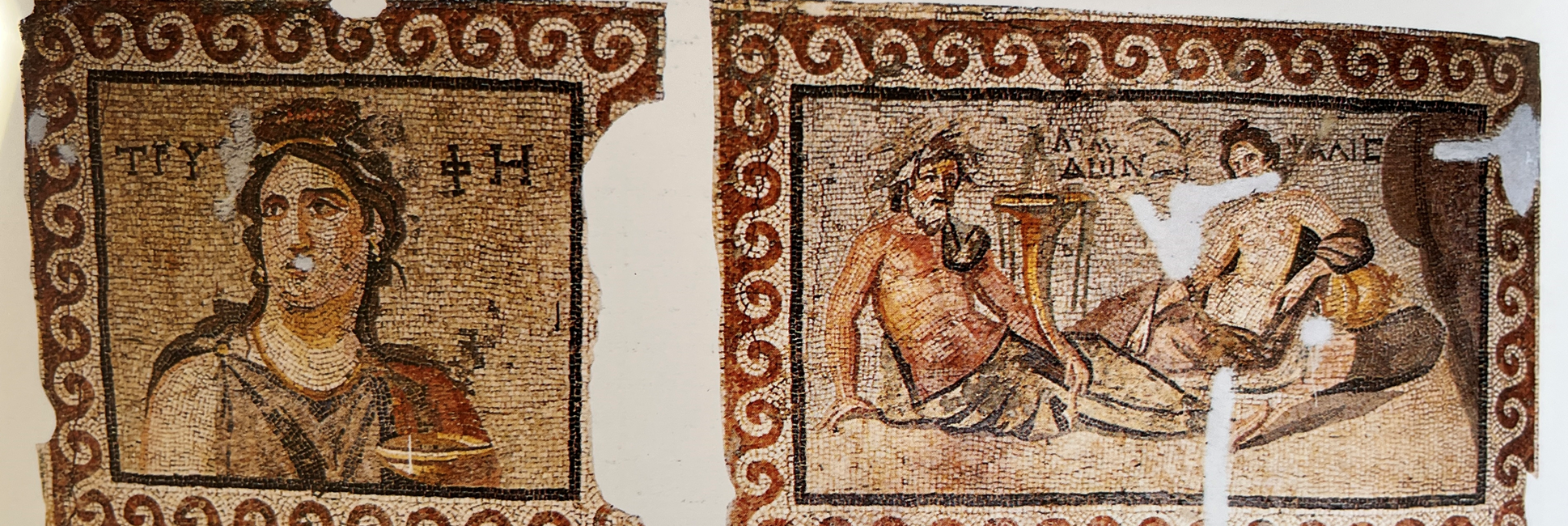Material Culture Week 10: Domestic decoration:
1/78
There's no tags or description
Looks like no tags are added yet.
Name | Mastery | Learn | Test | Matching | Spaced |
|---|
No study sessions yet.
79 Terms
Where are the earliest wall paintings from?
Earliest figurative painting from later Bronze Ages- Mycenean and Minoan
When was the golden age of paintings?
Famed Greek originals/painters- golden age of paintings- fifth- fourth centuries BC
Where were paintings typically found?
Painting decorated public buildings and tombs, few survive
What is the tetrachromy?
4 colour palette of black, white, red and ochre. Some use of these basic colours to create intermediate tones as well
Identify this:
Tomb of the Diver, Paestum, Italy ca. 470 BCE:
What do the images on the tomb of the diver relate to?
The images on some of the walls relate to a symposium
Identify this:
Detail in the drapery, diversity in colour, copy of a mastery painting
When did wall/panel paintings beome important in Rome?
Panel paintings imported into Rome in wake of Roman conquests:
Syracuse, 211 BCE and Corinth, 146 BCE.
Who did Pliny credit with making wall paintings important?
“But it was the dictator Caesar who gave outstanding importance to pictures by dedicating paintings of Ajax and Medea in front of the temple of Venus Genetrix”.
Pliny Natural History, 35.150.
How were these paintings displayed in the roman world?
Public to private. Historically in greek context the display in paintings took form in picture galleries, these galleries had the paintings displayed as panels enclosed with small shutters
Pinacothecae (picture galleries) - Vitruvius, De Architectura 4.2 and 4.8.
Owning greek art displayed roman power and success
Who is Vetruvius?
Architect, civil/military engineer – first century BCE.
What buildings does Vetruvius describe in his book De Architectura?
Describes buildings of all types including fortifications, temples, theatres, baths, aqueducts, as well as materials, machinery, instruments, materials, heating systems.
What does book 6 of De Architectura cover?
Book 6 describes and discusses domestic architecture and includes: climate, symmetry and siting, proportions of rooms, directions they should face, status of the owner, some different types of houses, and foundations. A lot of modern scholarship uses the terms Vitruvius used to describe a house
What does book 7 of De Architectura cover?
Book 7 includes recommendations for laying of pavements, the preparation and application of stucco work, wall paintings, the use of marble, and the processes for production of colours.
What does Pompeii allow us to do?
Snapshot in time. Allows us to study evidence of roman culture and life that we can't access elsewhere
What are problems with studying items from Pompeii?
Situation meant items moved from normal locations. As people were panicking they may have been trying to take things with them or store them.
Looting over time.
Haphazard excavations and paintings not as highly valued as other artworks. Other pieces of artwork were stolen, but impressive wallpaintings were cut out and taken
Reconstructions and wartime bombing. Bombing in WW2, so some damage from this. Lots of reconstruction overtime, not a lot of signposting indicating this
What do the names of houses in Pompeii rfelct, and give examples:
The names may reflect objects found (House of the Faun);
honour people at time of excavation (House of Queen Caroline)
may reflect who lived there (House of L. Caecilius Iucundus), this is generally taken from inscriptions in the houses, it may not reflect who truly lived in those houses
paintings found in the house (House of Menander).
How are the houses in Pompeii numbered?
Numbering: each building has 3 numbers which represent region, block of houses, and individual doorway.
What did Vetruvius say about what the rich deserve in his book?
“…for persons of high rank who hold office and magistracies, and whose duty it is to serve the state, we must provide princely vestibules, lofty halls and very spacious peristyles, plantations and broad avenues finished in a majestic manner….”
What did the roman domus play a role in?
The domus played a major role in social (and political) communication and demonstrated social standing.
What parts of the roman house were more public?
Patronage – the domus was where prominent men received their clients/hosted others.
Patrons received clients in the atrium and possibly tablinum. These were situated in the front of the house, so more public facing
What part of the roman house was more private?
Dinner held in the triclinium – further inside the house, less public
What did Wall paintings (and mosaics) in the domestic context enabled the elite to do?
project their economic and social prosperity/status (quality of artworks a part of this).
express their tastes and ideas related to social ideology.
reflect patron’s erudition (knowledge of Greek myth/epics/plays). This allowe them to project a cultured image of themselves
What was the atrium in a roman domus?
gave access to a number of rooms smaller rooms arranged around it.
household shrines often found in the atrium. Masks were also often kept here
multi-functional space.
Multiple rooms located around the atrium, the atrium acted as the one big connecting one
What is the peristyle in a roman domus?
comprised of open garden area with colonnade.
also often had main rooms such as a dining room (triclinium) opening from it.
Identify this house:
House of Menander, Pompeii, I 10 4:
What features are show in that image of the house of menander?
•Impluvium: a feature of the atrium style house. Collected rainwater from opening in roof (compluvium), which brought in air and light.
•Peristyle with colonnade: rooms opening from it were an extension of reception space.
What is a fresco/how is it made?
Frescoes – colours applied to wet plaster, pigments penetrated the plaster and fixed as it dried. (a watercolour painting done rapidly on wet plaster)
What do we know about frescoes?
Rare find as painted plaster is not durable – many left in situ have faded.
Wonderful wall paintings found in rome as well
Found in other places in the empire as well e.g. fragments of plaster found in the UK
What is the conetnt of wall paintings in Pompeii?
Religion – deities, rituals and related objects.
Architecture. Buildings and temples or architectural elements e.g. columns
Natural world – landscapes, still life.
Mythology. Major theme in wall paintings
Everyday life. Frieze in julius felix house depicting people going about their daily busness
What is the first style of wall paintings known as?
Also called “incrustation”, “structural” or “masonry” style.
When does this style date from?
Dates from 2nd century BCE.
What are key features of the first style?
Painted blocks; resemble masonry and marble.
3D effect created by each rectangle being surrounded by stucco moulding.
Vivid colours.
What is the second style of wall painting known as?
Also called ‘architectural’ style.
When does this style date from?
Approx dating of 110-80 BCE to 20-10 BCE.
What imagery appears in this style?
Some mythological imagery appears, mostly in friezes (e.g. Villa of the Mysteries).
What are key features of this style?
“Architectural” details: columns, buildings, doors, gates. (Possibly inspired by stage sets).
Sometimes incorporated First Style marble blocks at base of wall.
Illusion of looking through a window to the outside; perspective used to create depth.
Realistic feel; still life imagery; focal figures framed in alcoves.
What is megalaphoria?
Megalographia, narrative friezes (megalographia are the big ones, but there were smaller ones)
What is the third style of wall painting known as?
So-called “Ornate” or “Ornamental” style - colourful and finessed.
When does this style date from?
Approx. dating of 12 BCE to 40 CE.
What are ey features of the third style?
Illusionary depth disappears, walls divided into horizontal and vertical zones, divided by columns, foliage.
Larger expanses of same colour on walls – black, red and yellow popular, as is green/blue.
Egyptian influences – Nile scenes, deities, birds, lotus flowers.
Central picture panels – often vertical oblongs, but we do see smaller sized images as well
Mythological landscape scenes- large picture panels, featured in the centre space of the walls, dated to around 11 BCE
What is another name for the fourth style?
Also called “Intricate” style.
When does the fourth style date from?
Dating from 40 CE onwards.
What are key features of this fourth style?
Effect of a mosaic of framed pictures on some walls.
Eclectic, elements of previous styles used in combination.
Mythological imagery in central pictures; more square and generally smaller than Third Style.
Stencil type of patterns used as borders on a single colour (not shown here).
Central pictures more square and often smaller than Third Style.
How do we recognise characters and narratives in paintings?
Through iconography
What is iconography?
symbols and attributes = a visual shorthand which communicates to the viewer specifics of representation in an image.
Who are the people in this painting:

1st painting is mars and venus, we know this as mars we can recognise from his attributes, his plumed helmet (held by a small cupid), he also has a shield and a spear and a red cloak. We can recognise Venus by the small dove in the top corner, is associated with her. Holding up of the robe shows her displaying her beauty, mars grabbing her breast (sexual allsuion, possession/domination)
Identify the characters in this painting:

2nd paintings, Perseus and Andromadae, specific weapon which is a specific type of sword.
What do we know about the house of Menander?
•Extended over time to become a very large atrium-peristyle style house (over 2,000 square metres).
•Likely belonged to the gens Poppaea (seal bearing the name of Quintus Poppaea found in room 43).
•Redecorated in the Fourth Style between 45-55 CE.
•Mythological paintings in room 4 (and others).
Analyse this painting from the house of Menander:
Painting of Laocoon and his sons being strangled
By the serpent in the House of Menander. Laocoon
Is dressed in white in this painting, we can also see
A white bull and an overturned table, creates the
Idea tht this is relating to a sacrifice, bull appears to
Be dying in the painting
Analyse this image found in the house of Menander:
Image of Cassandra where they failed to believe her
Facial expression of horro, she is leaning away in shock
Analyse this painting found in the house of Menander:
Cassandra being pulled away from the temple by Ajax (about to be raped0, ehr clothing has fallen off)
Priam in the middle, his old age shows his helplessness
Helen at the side being grabbed by the hair
(vulnerbaility of the women in comparison to the men)
What did all these paintings have in common and what was the purpose of them?
The paintings were shown in the same room in the house of Menander:
All of these are from the trojan war
In the atrium, idea was to impress anyone visiting the house
When did the first mosaics appear?
Earliest patterned/figurative mosaics appeared around late fifth to early fourth centuries BCE.
What were these mosaics made from?
Made from small natural pebbles (limited colours).
What would these mosaics have been inspired by?
May have been inspired by textiles or vase painting.
give examples of places where mosaics were found?
Finest extant examples are from houses in mainland Greece: Olynthos, Eretria, Pella and Vergina (in Macedonia) in central Greece. They were mostly found in dining rooms
What would be happening in mosaics?
Subjects include: drinking/dining; vegetation; wild/marine animals – potentially allude to Dionysus.
Identify this mosaic:
Lion Hunt Pebble Mosaic, from Pella, Macedonia.
Late 4th century BCE.
What themes does the mosaic show?
Power, status, idealised masculinity
What did Pliny say about mosaics?
“In this latter field (mosaics) the most famous exponent was Sosus, who at Pergamum laid the floor of what is known in Greek (asaroton oecus) as ‘the Unswept Room’ because, by means of small cubes tinted in various shades, he represented on the floor refuse from the dinner table and other sweepings, making them appear as if they had been left there. A remarkable detail in the picture is a dove, which is drinking and casts the shadow of its head on the water, while others are sunning and preening themselves on the brim of a large drinking vessel”.
What does tessera mean?
tessera (-ae) = cut square piece of stone, glass or other material.
What does opus tessalatum mean?
opus tessalatum = mosaic made from tesserae.
What does opus sectile mean?
opus sectile = mosaic made from pieces of stone cut to specific shape to fit a design.
What does opus vermiculatum mean?
opus vermiculatum = finest technique of mosaic work - made from very small tesserae.
What does emblema mean?
emblema (-ata) = self-contained picture panel, set into larger mosaic/pavement.
What does lithostroton mean?
lithostroton = ‘strewn stone’; small irregular pieces of stone in different colours.
What different types of mosaics were there in the roman period?
lithostroton.
emblema.
Geometric.
Full pavements.
What does a lithostroton mosaic look like?
Where was lithostroton mosaic used?
This type of pavement was used in specific areas to not detract from the wall decoration, may have been used in less important areas
What does an emblema mosaic look like?
What does a full pavement mosaic look like?
Odysseus and Polyphemus
What was shown in Roman Eastern mosaics?
Dionysian and mythological imagery.
Personifications of seasons/ideas/geographical features. This is common throughout the whole empire
What is antioch?
Antioch – central city of Roman Syria (modern day Antakya, Turkey), situated on the river Orontes.
Where were mosaic floors usually found in the roman east?
T-shape and U-shape in mosaic floors (usually in rooms identified as triclinia).
Houses werelavishly decorated
identify this mosaic:

Mosaics from Room 13, Suite 3, House of Menander at Daphne
Analyse the mosaic:
Have inscriptions in greek, personification of Tryphe (right), personification of luxury. On the right there is the personification of Ladon. Reference to local topography in this mosaic, likely the owner of the house wanted to identify themselves with this part of local identity
What are mosaics like in North Africa (Bulla Regia)?
Province of Africa Proconsularis.
Highly colourful mosaics – local resources.
Imagery: marine, entertainment (amphitheatre/ animal/hunt scenes.
Bulla Regia (in modern day Tunisia) – a prosperous Roman colony.
What did mosaics in roman britain look like?
Mosaics from Isle of Wight to Yorkshire; some in south Wales, none in Scotland.
Range of imagery – mythological, deities/other religious content, personifications, hunt and arena.
Polychrome, generally white background.
Complexity in designs.
Geometric patterning with figures in separate framed panels.